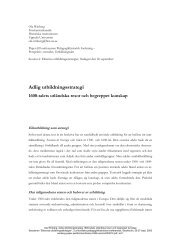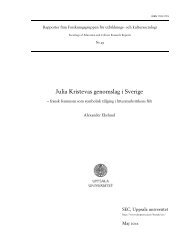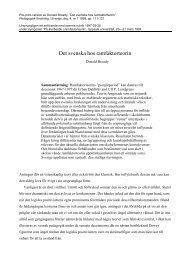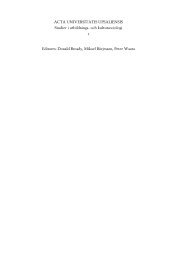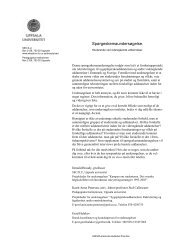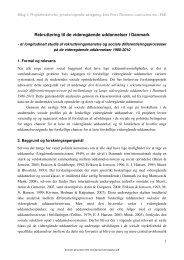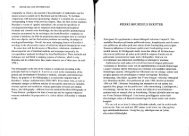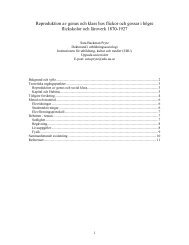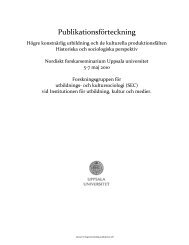exploring uses of digital archives in research and ... - skeptron.uu.se
exploring uses of digital archives in research and ... - skeptron.uu.se
exploring uses of digital archives in research and ... - skeptron.uu.se
You also want an ePaper? Increase the reach of your titles
YUMPU automatically turns print PDFs into web optimized ePapers that Google loves.
ob<strong>se</strong>rvations dur<strong>in</strong>g an <strong>in</strong>itial three weeks period this autumn (2003) <strong>and</strong> hopefully I willhave possibilities to do a follow-up study with<strong>in</strong> the next two years period. The <strong>in</strong>formants<strong>of</strong> the <strong>in</strong>terviews will be <strong>se</strong>lected with<strong>in</strong> the humanities comput<strong>in</strong>g community (<strong>and</strong> notonly the OTA) accord<strong>in</strong>g to availability (pragmatic reasons) but I till try to <strong>in</strong>terview tho<strong>se</strong>people, with<strong>in</strong> the community, who are either consider hav<strong>in</strong>g made major contributions tothe community work or are repre<strong>se</strong>nt<strong>in</strong>g contrast<strong>in</strong>g views or perspectives (relative to eachother <strong>and</strong> with<strong>in</strong> the community). The<strong>se</strong> people are not very difficult to discern, <strong>in</strong> fact byread<strong>in</strong>g the guidel<strong>in</strong>es <strong>and</strong> articles <strong>in</strong> the journals <strong>and</strong> study<strong>in</strong>g the conferences proceed<strong>in</strong>gsI have been able to depict possible c<strong>and</strong>idates for my forthcom<strong>in</strong>g <strong>in</strong>terviews. Oneimportant aspect <strong>and</strong> a difficulty I may encounter <strong>in</strong> ga<strong>in</strong><strong>in</strong>g access to this community isthat they do not know who I am - a totally new person who wishes to be a member <strong>of</strong> thiscommunity <strong>and</strong> at the same time would like to <strong>in</strong>vestigate what they are do<strong>in</strong>g.Here there are some issues which have to be considered. Firstly; how do I ga<strong>in</strong> access tothe <strong>in</strong>tended <strong>in</strong>formants <strong>and</strong> “trust” <strong>in</strong> this community <strong>and</strong> how to address the <strong>in</strong>formantsaccord<strong>in</strong>gly? Secondly; how do I h<strong>and</strong>le the fact <strong>of</strong> <strong>in</strong>vestigat<strong>in</strong>g the same community thatI want to be a part <strong>of</strong>? This might be more difficult than I <strong>in</strong>itially thought <strong>of</strong> <strong>and</strong> it has tobe dealt with <strong>in</strong> a <strong>se</strong>nsitive way. Bourdieu beg<strong>in</strong>s Homo Academicus with a discussion <strong>of</strong>the particular problems <strong>in</strong>herent <strong>in</strong> study<strong>in</strong>g ones own environment (I am not compar<strong>in</strong>gthis situation to what he is describ<strong>in</strong>g though). He discus<strong>se</strong>s the epistemological challenges<strong>in</strong>volved <strong>in</strong> break<strong>in</strong>g with everyday experience <strong>and</strong> reconstruct<strong>in</strong>g the knowledge obta<strong>in</strong>ed<strong>in</strong> the first break. 114 He also discus<strong>se</strong>s the <strong>se</strong>lf-reflection <strong>of</strong> this process, not<strong>in</strong>g that<strong>re<strong>se</strong>arch</strong>ers who study the same realm where s/he <strong>se</strong>lf operates can u<strong>se</strong> the results from the<strong>re<strong>se</strong>arch</strong> – <strong>and</strong> so to speak re<strong>in</strong>vest the results - as tools for <strong>se</strong>lf-reflection <strong>of</strong> the limits <strong>of</strong>the <strong>re<strong>se</strong>arch</strong> <strong>and</strong> to underst<strong>and</strong> what s/he is motivated to <strong>se</strong>e <strong>and</strong> not to <strong>se</strong>e. 115The other ca<strong>se</strong> study is planned to take part with<strong>in</strong> the bio<strong>in</strong>formatics community <strong>in</strong>Sweden. This community I hope to ga<strong>in</strong> access to through my earlier work <strong>in</strong> <strong>and</strong>collaboration with the Bio<strong>in</strong>formatics project. 116 This study might be on accomplisheddur<strong>in</strong>g a longer time period, but the ob<strong>se</strong>rvations will not be done any more thanapproximately three to four weeks altogether. F<strong>in</strong>d<strong>in</strong>g suitable <strong>and</strong> be <strong>in</strong>troduced topossible <strong>in</strong>formants for the <strong>in</strong>terviews will be due to my earlier contacts with lead<strong>in</strong>gscientists <strong>in</strong> this field. I am not sure if there will be a problem to ga<strong>in</strong> access to one or twophysical places where I can do the ob<strong>se</strong>rvations.Considerations concern<strong>in</strong>g both ca<strong>se</strong> studiesThe problem I believe will rather be how to collect records <strong>of</strong> what they actually are do<strong>in</strong>gwhen they are work<strong>in</strong>g with their <strong>digital</strong> <strong>archives</strong>. Here I envision that I will ask them todescribe out loud what they are do<strong>in</strong>g <strong>and</strong> then collect different repre<strong>se</strong>ntations <strong>of</strong> theirwork.Dur<strong>in</strong>g the <strong>in</strong>terviews I will ask the <strong>re<strong>se</strong>arch</strong>ers/<strong>in</strong>formants to describe their recent work<strong>and</strong> to discuss the <strong>in</strong>formation proces<strong>se</strong>s <strong>in</strong>volved <strong>in</strong> a specific <strong>and</strong> recent activity/task(such as do<strong>in</strong>g an analysis, add<strong>in</strong>g a record or prepar<strong>in</strong>g teach<strong>in</strong>g 117 ) related to the personbe<strong>in</strong>g <strong>in</strong>terviewed <strong>and</strong> related to the actual u<strong>se</strong> <strong>of</strong> <strong>digital</strong> archive(s): e.g. what was u<strong>se</strong>d;how was it u<strong>se</strong>d; <strong>and</strong> how the <strong>in</strong>terviewee worked through the activity <strong>in</strong>clud<strong>in</strong>g any the114 Bourdieu, 1996a: 35.115 ibid. p.48116 This project was formally named the Life Science Project <strong>and</strong> was a three year project (1999-2001) with<strong>in</strong>the Wallenberg Global Learn<strong>in</strong>g Network funded by the Knut <strong>and</strong> Alice Wallenberg Foundation. SeeAndersson, Langerth Zetterman & Strömdahl, 2001 for a description <strong>of</strong> work undertaken <strong>in</strong> this project.117 Associated cour<strong>se</strong>s with<strong>in</strong> the<strong>se</strong> communities might also <strong>se</strong>rve as a part <strong>of</strong> the empirical material.pm-030505.doc utkast avh.pm. Monica Langerth Zetterman 25(34)



